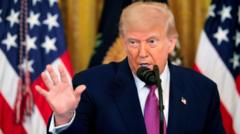As of June 22, 2025, escalating tensions in the Middle East have drawn international concern following a series of U.S. military strikes aimed at Iranian nuclear sites. The surprise attack included precision strikes on key facilities such as Fordo, Natanz, and Isfahan, which the Trump administration claims were vital to crippling Iran's nuclear capability. President Trump delivered a strong message warning that Iran must "make peace" or face more intense military actions.
**U.S. Strikes Iran: Tensions Escalate as Iran Responds Vigorously**

**U.S. Strikes Iran: Tensions Escalate as Iran Responds Vigorously**
In the wake of U.S. military strikes targeting Iran's nuclear facilities, tensions in the Middle East rise sharply. Iran vows to defend itself as both nations brace for potentially explosive consequences.
Iran's retaliation began swiftly after the strikes, with missiles fired toward Israel, injuring at least 16 people as air raid sirens echoed across the country. Iranian officials, including Foreign Minister Abbas Araghchi, condemned the U.S. actions as a violation of international law and vowed to respond decisively, underlining Iran's right to defend its sovereignty.
Amidst the diplomatic fallout, calls for de-escalation surfaced from various international leaders. European Union officials urged a return to negotiations, while Russian officials condemned the U.S. strike as irresponsible. Notably, the potential for renewed diplomatic discussions appears grim, as Araghchi stated that the door to talks is closed for now, reflecting heightened hostility in the region.
Furthermore, speculation has arisen regarding Iran’s claims of new, undisclosed nuclear sites, raising concerns about the continuity of its enrichment activities. This new assertion adds complexity to an already volatile situation, as reports suggest that Iran may have constructed additional underground facilities, potentially increasing its capacity to produce weapons-grade uranium.
As global leaders assess the ramifications of the U.S. actions, the situation remains precarious. With military options on the table and conflicting interests among Iran, the U.S., Israel, and regional allies, the stakes continue to rise, leading to fears of a broader armed conflict in the Middle East.
While further military actions loom, the international community watches closely, weighing the consequences of choices made in this ongoing confrontation. As the dust settles from the latest strikes, questions about Iran's nuclear ambitions and the future of U.S.-Iran relations remain at the forefront.
Amidst the diplomatic fallout, calls for de-escalation surfaced from various international leaders. European Union officials urged a return to negotiations, while Russian officials condemned the U.S. strike as irresponsible. Notably, the potential for renewed diplomatic discussions appears grim, as Araghchi stated that the door to talks is closed for now, reflecting heightened hostility in the region.
Furthermore, speculation has arisen regarding Iran’s claims of new, undisclosed nuclear sites, raising concerns about the continuity of its enrichment activities. This new assertion adds complexity to an already volatile situation, as reports suggest that Iran may have constructed additional underground facilities, potentially increasing its capacity to produce weapons-grade uranium.
As global leaders assess the ramifications of the U.S. actions, the situation remains precarious. With military options on the table and conflicting interests among Iran, the U.S., Israel, and regional allies, the stakes continue to rise, leading to fears of a broader armed conflict in the Middle East.
While further military actions loom, the international community watches closely, weighing the consequences of choices made in this ongoing confrontation. As the dust settles from the latest strikes, questions about Iran's nuclear ambitions and the future of U.S.-Iran relations remain at the forefront.























